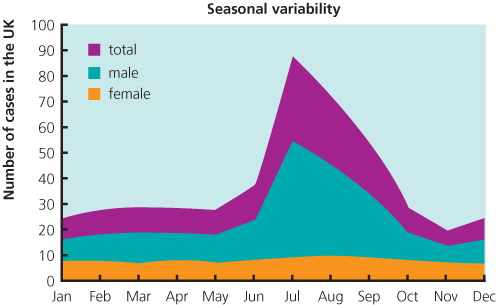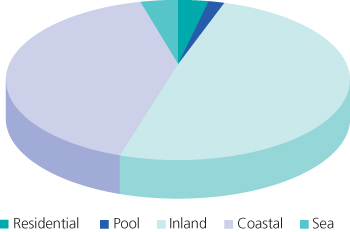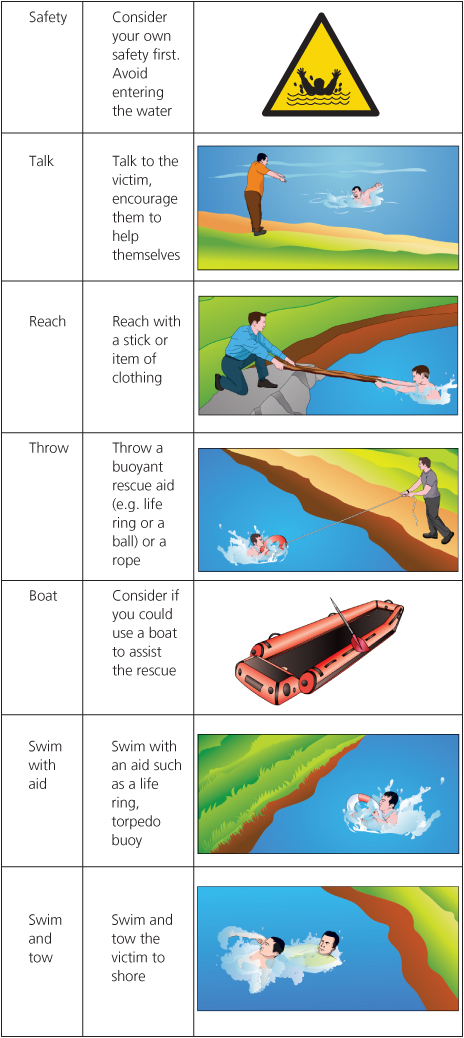Introduction
Worldwide, there are approximately 450,000 deaths each year from drowning. Most occur in low- and middle-income countries, but in 2006 there were 312 accidental deaths from drowning in the UK and 3582 in the USA, an annual incidence of 0.56 and 1.2 per 100,000 population respectively. Drowning is the leading cause of accidental death in Europe in young males. It occurs most commonly during the warmer summer months (Figure 16.1). Contrary to popular perception, nearly half of drowning cases occur in inland waterways. Drowning in a swimming pool is relatively rare (Figure 16.2).
Definition
Many definitions and sub-definitions of drowning exist which have resulted in confusion and inability to compare studies on management and outcome. To try and simplify matters, an advisory statement from the International Liaison Committee on Resuscitation (ILCOR) was published in 2003 under the title Recommended Guidelines for Uniform Reporting of Data From Drowning. The “Utstein Style”. In it, drowning was defined as a process rather than an event:
Drowning is a process resulting in primary respiratory impairment from submersion/immersion in a liquid medium. Implicit in this definition is that a liquid/air interface is present at the entrance of the victim’s airway, preventing the victim from breathing air. The victim may live or die after this process, but whatever the outcome, he or she has been involved in a drowning incident.
ILCOR also recommended that certain, ill-defined terms should be abandoned, including: wet/dry drowning; active/passive/silent drowning; secondary drowning; near-drowned; drowned.
The sequence of events in drowning that lead to death are summarised in Box 16.1.
The need for oxygen
When cardiac arrest occurs due to a primary cardiac cause (sudden cardiac death – SCD) the problem is one of failure to circulate blood that, at least initially, is well oxygenated. When cardiac arrest occurs following drowning, the primary cause is hypoxia. In SCD, the priority of treatment is chest compression; in drowning, it is ventilation. Because around 70% of out-of-hospital cardiac arrests in developed countries are due to SCD, standard BLS guidelines are aimed at the majority case with the emphasis on chest compression. One of the important differences to be remembered when managing a case of drowning is that restoration of adequate ventilation is a prime objective.
The earlier that rescue occurs in this sequence the greater chance of survival
- Breath holding
- Laryngospasm
- Hypoxia and hypercarbia
- Swallowing
- Water inhalation
- Surfactant wash out, pulmonary hypertension, shunting
- Worsening hypoxia
- Loss of consciousness
- Death
The drowning victim
In many cases the victim has first to be rescued to dry land before definitive treatment can start. This presents dangers for the rescuer. Never enter the water unless absolutely necessary (Figure 16.3): consider reaching to the victim with a stick or throwing a rope or floating aid if the victim is near to land. If these will not reach and no boat is available, carefully weigh up the potential dangers of entering the water. If you have one, wear a lifejacket and take a floating aid with you. It is safer to go with another rescuer than on your own. Even then, be very wary of getting too close to a panicking victim who may grasp and pull you under the water. Even an apparently unconscious victim may ‘recover’ and grab you; the result can be two drowned victims rather than one.
< div class='tao-gold-member'>












